
© Railway Wonders of the World 2012-


The Railways’ Daily Work
Widespread Activities of Four Great Companies
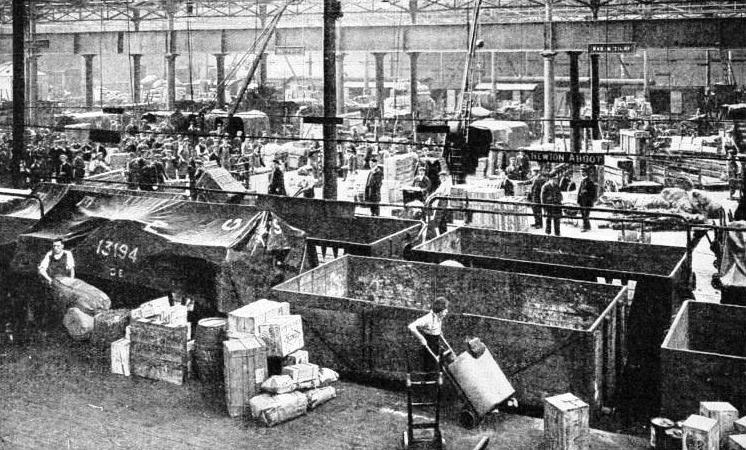
THE GOODS STATION at Paddington, the London terminus of the Great Western Railway. In one year the British railways carried over 260,300,000 tons of freight, and the freight train mileage in 1934 was 128,683,000. The goods shed at Paddington contains fourteen main tracks arranged in pairs with a platform 600 ft. long between each pair. The total amount of steelwork in the roof and columns is 1,600 tons. This goods station possesses all the latest loading devices.
EVERY minute of the twenty-
The term “railway” is quite inadequate to describe the ramifications of the system. For three-
A British railway may, therefore, well be regarded as an immense department store, or universal provider, of transport. It thus differs from the railways of most other countries, which for the greater part do not own hotels, steamships or docks -
The British railways -
To this day, as in the beginning, by far the largest single item of traffic carried by the British railways is coal. The exact beginnings of the railway are difficult, if not impossible, to trace, but in this country they were certainly connected with coal. According to some historians, a primitive form of railed track may have been in use in the Scandinavian countries as early as the sixteenth, or even the fifteenth, century. Be that as it may, we know that a line with wooden rails was built at Newcastle about 1602 for the haulage of coal from a local mine to a convenient point of shipment on the River Tyne. This little colliery line was the ancestor both of the British railway in particular and of railways in general.
Well before the opening in 1825 of the Stockton and Darlington (the first public railway in the world) a relatively considerable railway mileage had already been built in England and Scotland With the exception of the Surrey Iron Railway, these lines were built solely for the conveyance of coal, and carried no other traffic. The Stockton and Darlington line was originally planned for “the more easy and expeditious carriage of coals, lead, etc”. The conveyance of passengers, who travelled at first in horse-
Coal is still the backbone of the British railway business Of the railway receipts proper, apart from those of the steamships, docks, and other subsidiary businesses, over half are earned by the goods department. This figure would be still higher if it were not for the fact that the Southern is pre-
Owing both to the great density of traffic, and to the fact that merchandise is normally carried in small consignments, which in turn means relatively small wagons and short trains, the proportion of locomotives to mileage in Great Britain is exceptionally high. In round figures, the four main railways own 19,300 miles of route, and 50,700 miles of track, including sidings and those sections of line on which two or more running roads are provided. This proportion of track to route mileage -
Excluding Diesel engines and cars, steam and electric rail motors, and other forms of traction, the work of the British railways is done by approximately 20,500 steam locomotives, of which rather less than two-
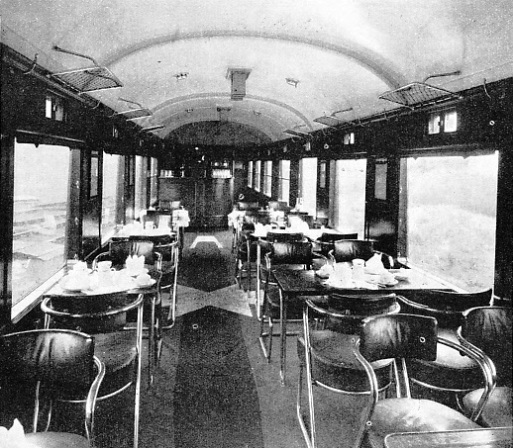
MODERN SIMPLICITY COMBINED WITH COMFORT is the note struck by the interior of this London, Midland and Scottish buffet car. The LMS Railway owns over 24,000 coaching vehicles, which include passenger carriages and brake vans.
The locomotive is, of course, the keystone of the railway structure. One of the great preoccupations of engineers and managers is naturally to obtain the utmost amount of useful work from each machine. Locomotives are designed with an eye to fuel economy, since a variation of a shilling a ton in the price of coal means a saving or an extra expenditure of about three-
In the long run these decreases become remarkable. Thus, while the London, Midland and Scottish Railway had 9,800 locomotives in service at the end of 1929, the figure had dropped to 8,004 by December, 1934. In other words, eight locomotives are now doing the work that six years earlier required ten. This result has largely been made possible by a considerable reduction in the average time during which locomotives are under or awaiting repairs. This means a reduction in the number of engines in the “shops” at a particular time, and a consequent increase in the work obtained from each engine. The reduction is also due to the rapidly increasing tractive power and efficiency of the standard types now being built.
In addition to locomotives, the working stock of the main British railway system includes, in round figures, 61,000 passenger carriages and other coaching vehicles, together with electric stock, and a total of 619,000 goods and mineral wagons and departmental vehicles. The latter figure includes coal wagons for the use of the locomotive department, ballast wagons and brake vans, timber, rail and sleeper trucks, breakdown and travelling cranes, gasholder trucks, mess and tool vans, and other miscellaneous stock. This gives approximately one locomotive to every thirty-
The tendency for the number to decline is not confined to locomotives. During 1929-
Speeding Up Repairs
Here, also, a large increase in capacity has gone hand-
Another reason for the decrease both of rolling-
These figures indicate an even more striking speeding up than is to be seen on the surface. As many as 6,594 of the locomotives underwent renewals or light or heavy repairs during 1934, while the figures for coaching stock and goods and mineral vehicles were 12,219 and 498,972 respectively. In other words, most of the locomotives and over half the coaching vehicles went through the “shops” during the year, while every wagon was dealt with nearly twice, yet the waiting list represented so very small a proportion of the total. Expeditious work of this nature so shortens the time during which locomotives and rolling-
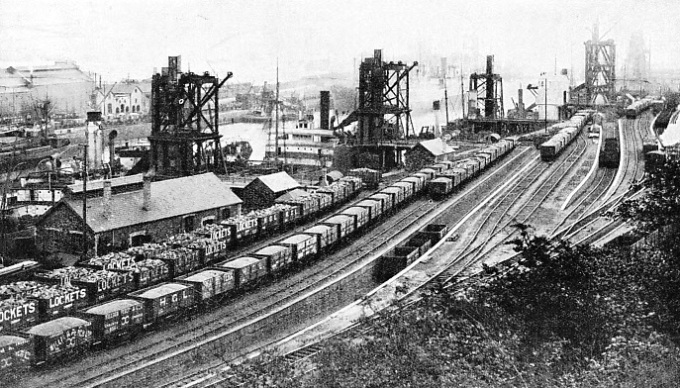
THE PENARTH DOCKS, South Wales, controlled by the Great Western Railway. The Company’s ports in South Wales handle together some 50,000,000 tons of freight in a year, three-
One word more before we leave the locomotive department. Each of the steam locomotives owned by the British main line companies runs an average of approximately 24,000 miles a year, nearly equal to a journey round the world at the equator. As with most figures relating to railway operation, this is also more striking in reality than appears on the surface. The average figure embraces every kind of work performed by every type of locomotive. A large proportion of the total amount of locomotive work, especially that in connexion with goods traffic, necessarily involves many stops and a low running speed. We thus have, on the one hand, the shunting engine, for which a hundred miles may represent a good day’s work, and, on the other, the passenger locomotive performing such long non-
Next to the railway system proper, the largest business conducted by the British companies is that of dock owners. The railway-
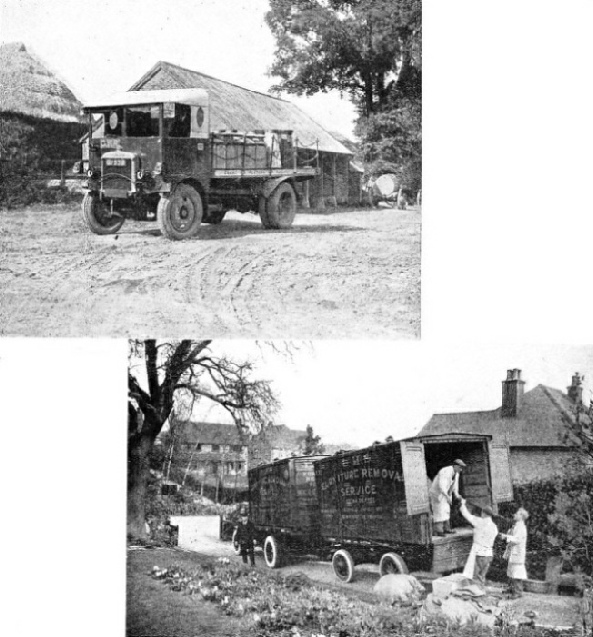 COUNTRY LORRY SERVICES are run by the Great Western Railway to collect milk from farms for distant stations (above). In one year the railways carried 173,894,000 gallons of milk.
COUNTRY LORRY SERVICES are run by the Great Western Railway to collect milk from farms for distant stations (above). In one year the railways carried 173,894,000 gallons of milk.
THE FURNITURE REMOVAL SERVICE organized by the London Midland and Scottish Railway (below). Special containers are used to convey the goods from house to house, the container being designed to be easily lifted from the van onto the railway wagon for transit by rail. At the end of the rail journey the container is placed again on a road vehicle, and thus the door-
Southampton, with a total quay length of 30,068 feet and the largest dry dock in existence, is a striking example of a railway-
The magnitude of the railway-
From the ownership of docks and harbours to that of steamers is a logical step. Almost the whole of the cross-
The cross-
The Great Western joins South Wales and Southern Ireland by means of the Fishguard-
Three services are run by the LNER from Harwich -
The LMS operate or are interested in five sea routes between Great Britain and Ireland: Heysham-
On the Clyde the LMS and LNE Railways operate extensive steamer services to and from the many coast resorts, and those in Bute and Arran; the LMS services are run by a subsidiary company under LMS control. LMS steamers run on certain of the English lakes.
The total railway-
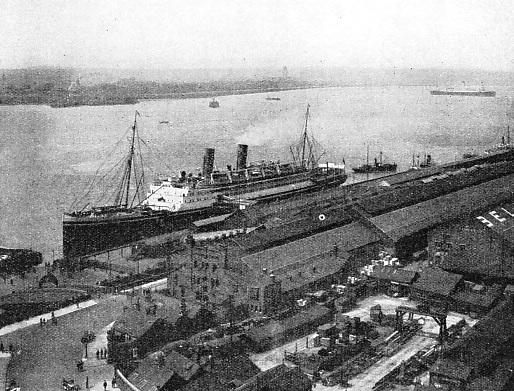
THE RIVERSIDE STATION and landing stage at Liverpool, served by boat expresses from Euston. In normal times through coaches for Atlantic passenger traffic are attached to one of the Liverpool expresses. It will be seen that the station adjoins the berthing place of the steamers. The docks extend for about seven miles. Should traffic be extra heavy, special trains are run.
The British railway fleet varies considerably both in size and character. Thus, at the one end of the scale are the fast turbine vessels, and at the other a number of steamboats of under 250 tons. In between come such special craft as the Southern Railway’s Auto-
At one time it was the fashion to call the subsidiary railway businesses “side shows”, but, save for such exceptions as the limestone quarry owned by the London, Midland and Scottish, each of these “side shows” is a considerable undertaking in itself. The hotels, for instance. Not many people, even those with a good knowledge of railways, realize that the four great British railway companies own the largest chain of hotels in the world The total number, including those managed by the companies for other proprietors, is seventy-
Restaurant Cars for All
Allied to the hotel business is that of restaurant cars and refreshment rooms. Excluding Pullman cars, which are not owned by the railway companies, there is a total of nearly seven hundred restaurant cars in service. This facility is equally available to the third-
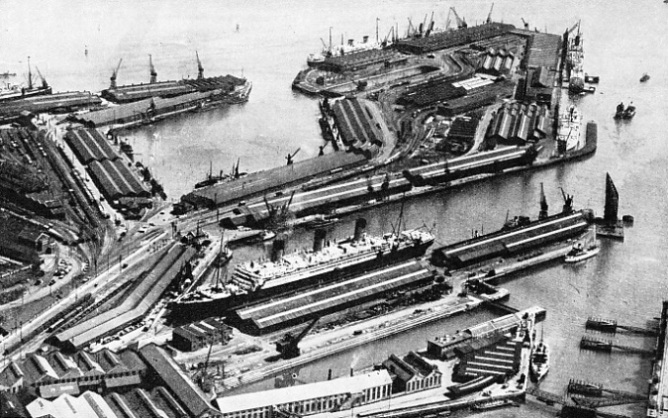
A MAGNIFICENT AERIAL VIEW of the Southern Railway’s docks at Southampton, showing the railway lines up to the berthing places. Southampton has a total quay length of 30,068 ft. In one month 460 vessels with over 31,000 passengers have been handled by the port. The docks were formerly owned by the London and South Western Railway, which purchased them in 1892.
Another important business operated by the British railways is that of cartage. This has grown to its present dimensions because of certain operating conditions peculiar to Great Britain and Ireland. The majority of the merchandise consignments are small in bulk, weighing less than half a ton, largely because the speed of the goods services makes it unnecessary for a trader to hold large stocks of merchandise when the railway will so quickly bring a fresh supply to his warehouse or shop. As was declared over forty years ago by one of the most celebrated of all the writers on English railways, “celerity in goods traffic seems to have been a special feature of English railway management from the very first. . . Speaking broadly, it may be said that the whole English goods traffic is nowadays organized on this basis -
If all this was true in 1890, it is much truer to-
The container is not a recent innovation. It was used for coal traffic on the Liverpool and Manchester Railway almost at its opening. It was adopted with a considerable measure of success on the Canterbury and Whitstable line. In the ‘forties its use was suggested as a means of overcoming the inconvenience due to the break of gauge when transferring goods between the Great Western and Midland systems. For decades it has been employed on the cross-
The four main railways own, in round numbers, 36,600 road goods vehicles and 14,200 horses, the latter including over four hundred used for shunting purposes. The railways still rely largely on animal traction, considerably less than half their road vehicles being motor driven, though about 1,600 “mechanical horses” were in use in 1934. Experience has shown that each type of vehicle has its advantages.
The above figures are far from showing either the full scope or the real magnitude of the highway business carried on by the railway companies, since their accounts and statistical returns do not show the fleets of the passenger transport concerns in which they are interested, or of the large cartage undertakings that they have lately absorbed.
An interesting history is attached to these controlled road undertakings. The British railways were pioneers in the introduction of mechanical traction on the roads. Some of the earliest motor omnibuses seen in the country were owned and operated by the Great Western and North Eastern Railways. The North Eastern introduced motor coaches over a quarter of a century ago. But the British railway companies are statutory undertakings, which means, among other things, that they are often not free to undertake a particular business unless specifically authorized by Parliament to do so. They did not consider themselves free to undertake mechanical road traction on any considerable scale until the passing of special legislation in 1928. Since then, instead of competing with existing road services, they have acquired an interest in most of the principal passenger-
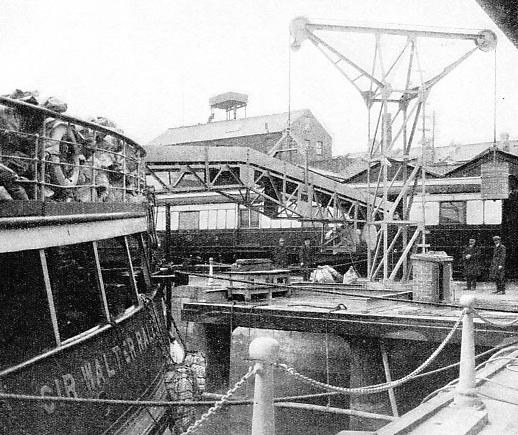
TRANSFERRING MAILS from a tender at Plymouth to a Great Western train by means of an automatic conveyor. In 2½
Hours the conveyor has loaded some 52 tons of mail bags.
The thousand miles of railway-
Most people probably imagine that the land and property owned by the railway companies is restricted to tracks and sidings, stations, warehouses, shunting yards, workshops, locomotive and carriage sheds, and the like. But the item officially known as “land, property, etc, not forming part of the railway or stations”, represents another considerable business, amounting to 35,000 acres of agricultural, urban and suburban land, and over 53,000 houses and cottages, of which 28,000 are occupied by the members of the staffs. With the exception of certain local authorities, such as the London County Council, the railway companies are the largest individual house owners in the country. This property ranges from small dwellings to large houses in residential districts, as, for instance, Hampstead. Much of it has been acquired to secure in advance land that may be needed for future track widening or station enlargements. This was done by the Great Central Railway when it built its London Extension. Hence the London and North Eastern Railway, in which the Great Central is absorbed, owns a number of houses in the immediate neighbourhood of Lord’s Cricket Ground.
To deal fully with the many and varied activities of the British railway system would require a large-
It has been said by a great authority that British railways “now sell service, whereas they used only to run trains”. Here we have in the fewest words a definition of the new spirit of enterprise that has characterized the administration and management since grouping in 1923. This wholesale amalgamation brought in its wake many new problems, since twenty-
Railways and Social Life
The enormous difference that the railway companies have made in the social life of Britain cannot be exaggerated. The sites of our homes are dictated in some measure by the railways. Particularly is this so in the London area, where the provision of a fast and frequent electric train service has made it possible for the City worker to live ten, twenty, or thirty miles out of town in rural surroundings. Reasonable season-
A comparison between life in a country district and that in the smoke-
A sidelight on this phase of the railways’ activity is furnished by the camping and holiday cruising arrangements now made for the public. Full descriptions of both these delightful ways of spending a holiday have appeared in earlier chapters.
There are other angles, however, from which the railway industry of Britain may be viewed. For example, the financial importance of British railways can be gauged from the tact that the capital receipts for the four main British groups, namely the Great Western, the London and North Eastern, the London, Midland and Scottish, and the Southern Railway, to the end of 1934 amounted to no less than £1,092,000,000, while the capital expenditure was £1,154,000,000. It would seem from these figures as though the expenditure exceeded the receipts, but the difference is met, temporarily, by various renewal, superannuation, and savings bank funds. About ten per cent of the total expenditure relates to docks, steamships, hotels, and other subsidiary businesses conducted by the companies.
One aspect of the railways’ national importance is apt to be overlooked, and that is that the various companies are the country's best customers, since their purchases reach colossal proportions. For example, the companies between them purchase no fewer than 14,000,000 tons of coal every year to supply the needs of some 20,000 locomotives and for steamships, hotels, offices, and works. British brick-
In giving their multitudinous services the railways also find employment for a vast number of men and women.
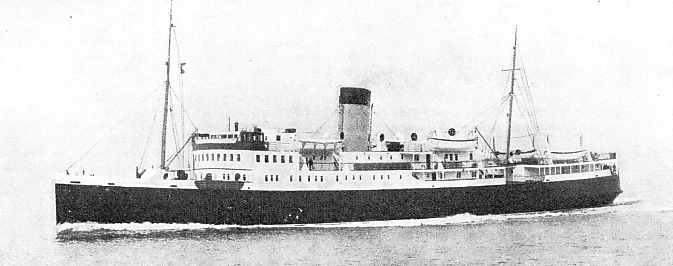
ON THE STRANRAER-
You can read more on “Goods Trains and Their Working”, “The Railways Take All” and
“Rolling Stock Construction” on this website.
You can read more on“LMS steamship services” in Shipping Wonders of the World